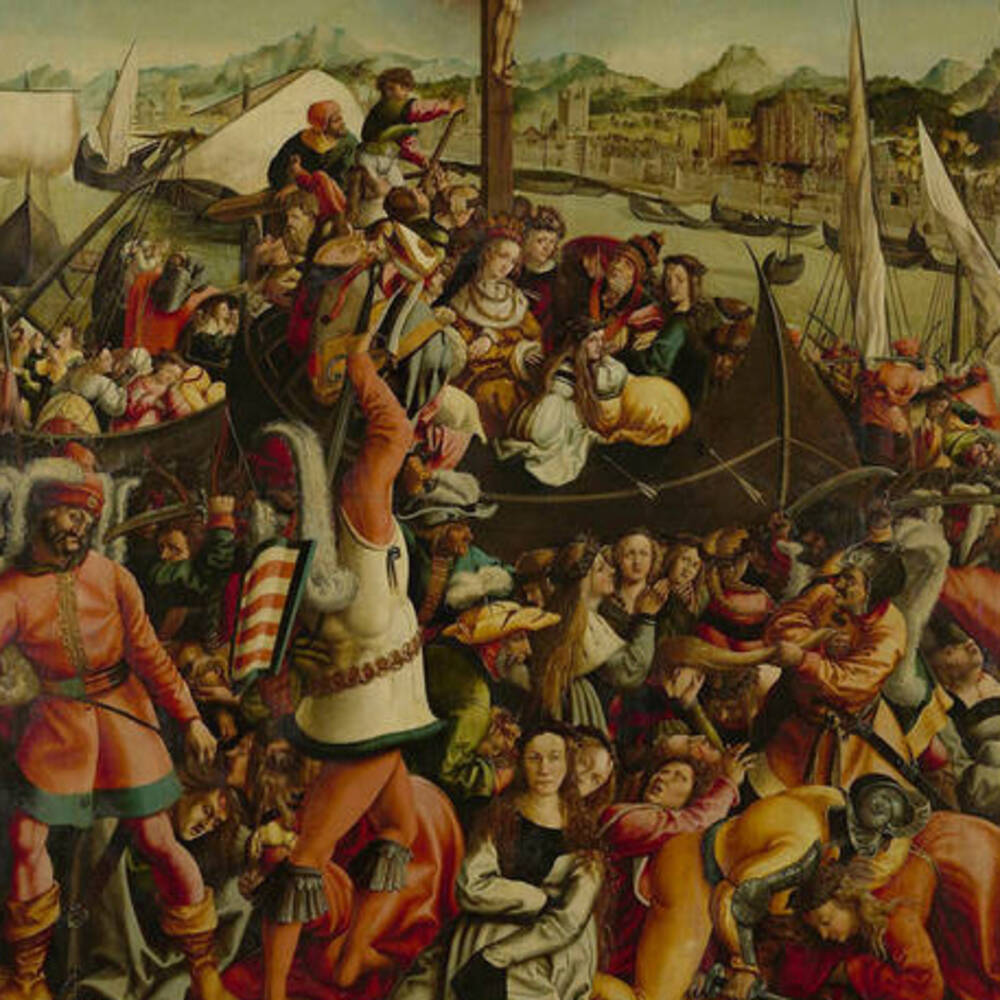This martyrdom scene extends across the central panel and the wings. According to the “Golden Legend”, Ursula and her 11,000 companions were killed by the Huns on their way back from Rome to Cologne. The unfinished Cathedral and Great St Martin are visible on the skyline. Ursula sits with Pope Cyriacus beneath the crucifix on the boat, pierced by an arrow. On the outer side of the right-hand panel she appears holding this attribute, while the left-hand panel features a depiction of St George.
Further Media



The fascination of this winged altarpiece by Jörg Breu the Elder comes, not least, from the detailed rendering of the events.
He takes as his subject the Romans’ fear of the growing community of Christians. As legend recounts, the Emperor himself commissioned the Huns to massacre Ursula and her followers. Jörg Breu the Elder shows the warriors dressed in the uniforms of Janissaries, the elite infantry units in the Ottoman Sultan’s household troops – resonating with the Ottoman Empire’s attempts to expand its sphere of influence.
Yet Breu does not just focus on the action; he also sets it in a lyrical yet realistic landscape. In keeping with the legend of Saint Ursula and the eleven thousand virgins massacred on their return to Cologne, he paints a detailed image of the city of Cologne on the opposite riverbank. He evidently kept very closely to the appearance of early sixteenth-century Cologne – which during Breu’s lifetime already had 40,000 inhabitants and was thus one of the largest cities north of the Alps. The many ships at anchor on the opposite bank of the river underscore Cologne’s role as an important trade centre on the River Rhine. The riverbank is secured by the city wall – and behind it, to the left, we can see the Romanesque Great Saint Martin Church. The church, with its square crossing tower and characteristic corner towers – still to be seen today – rises up above the sea of houses below. One other prominent feature in the cityscape is further to the right – the cathedral, not yet finished at that time and so still without its twin spires. Incidentally, the mountains in the background are an invention added by Breu.
His exact depiction of Cologne, though, also evokes the strong links between the city and the veneration of Saint Ursula. However, as yet, we do not know whether the altarpiece was actually painted for a church in Cologne.
The main figure on this altarpiece is Saint Ursula, prominently placed on the ship on the central panel – but you may have noticed another prominent figure as well. Directly in the foreground, there is a woman with long curly hair. She is wearing a black gown covered by a white cloak. Solemnly, she gazes out at us while the brutal massacre proceeds behind her.
This attractive unknown woman may possibly be a portrait of Elisabeth of Schönau, who lived in the twelve century and was a Benedictine abbess. In visions, she saw the revelation of the martyrdom of Saint Ursula and the eleven thousand virgins. She related her visions to her brother Egbert, a Benedictine abbot, who wrote them down for posterity. As these writings spread, they triggered a strong interest in the veneration of Saint Ursula in the Middle Ages.
However, this figure of a woman could also be a donor portrait. As a rule, though, at that time donor portraits were placed as onlookers of the religious event. Only later were they included in the drama of the scenes themselves. Possibly, though, the figure could be a mix of all of this?
By setting the woman in front of the action and facing the viewer, Jörg Breu may have wanted to indicate she was not herself part of the event; either she experienced it centuries later in the form of a vision or she was a pious donor seeking, in this way, to visibly express her link to the saint.
But there is also a third possible reading. The woman could be Saint Cordula, one of Ursula’s companions. As the massacre started, she managed to hide herself in the ship. The next day she was ashamed of what she had done, emerged from hiding – and suffered the same fate as all her companions. This explanation would also be supported by Breu depicting this figure with her hair untied and wearing a martyr’s wreath.
- Location & Dating
- c. 1522/27
- Material & Technique
- Oil on limewood panel
- Dimenions
- 215 x 162 cm (Mitteltafel), 173 x 77 cm (jeder Flügel)
- Museum
- Gemäldegalerie Alte Meister
- Inventory number
- Gal.-Nr. 1888